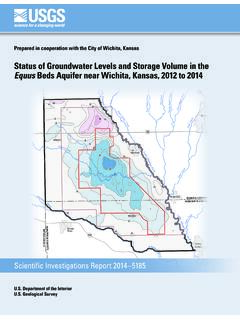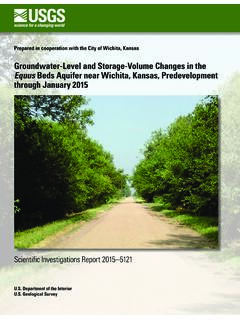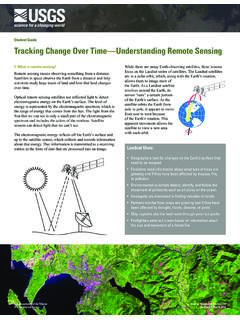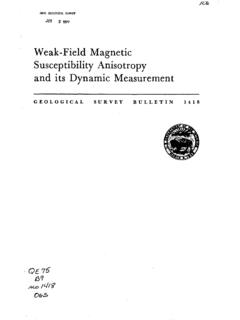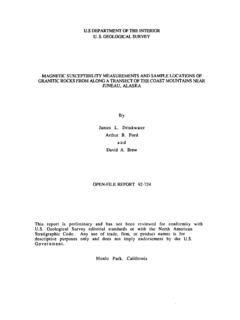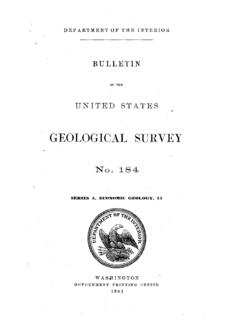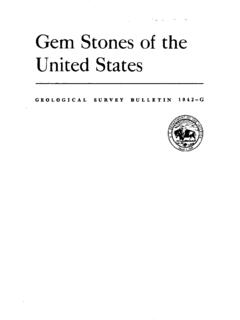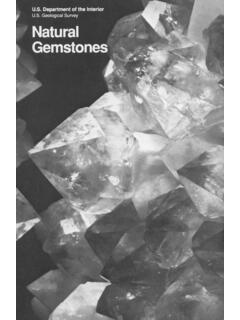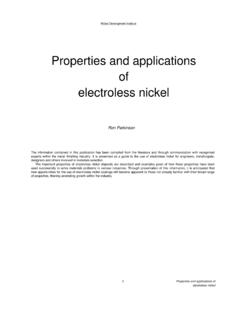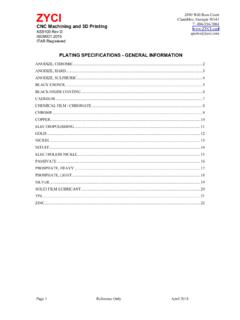Transcription of Nickel - USGS
1 Prepared by Michele E. McRae [(703) 648 7743, Nickel (Data in metric tons of Nickel content unless otherwise noted) Domestic Production and Use: In 2020, the underground Eagle Mine in Michigan produced approximately 16,000 tons of Nickel in concentrate, which was exported to smelters in Canada and overseas. A company in Missouri recovered metals, including Nickel , from mine tailings as part of the Superfund Redevelopment Initiative. Nickel in crystalline sulfate was produced as a byproduct of smelting and refining platinum-group-metal ores mined in Montana. In the United States, the leading uses for primary Nickel are stainless and alloy steels, nonferrous alloys and superalloys, electroplating, and other uses including catalysts and chemicals. Stainless and alloy steel and Nickel -containing alloys typically account for more than 85% of domestic consumption. Salient Statistics United States: 2016 2017 2018 2019 2020e Production: Mine 24,100 22,100 17,600 13,500 16,000 Refinery, byproduct W W W W W Imports: Ores and concentrates (1) 64 3 4 120 Primary 111,000 150,000 144,000 119,000 110,000 Secondary 32,300 38,100 45,100 37,700 32,000 Exports: Ores and concentrates 22,400 20,000 18,000 14,700 13,000 Primary 10,300 11,000 9,780 12,800 11,000 Secondary 63,700 51,500 59,400 51,100 34,000 Consumption: Reported, primary metal 97,800 105,000 107,000 105,000 85,000 Reported, secondary, purchased scrap 131,000 133,000 123,000 111,000 100,000 Apparent, primary metal2 104,000 140,000 136,000 106,000 99,000 Apparent, total3 235,000 273,000 259,000 217,000 200,000 Price, average annual, London Metal Exchange (LME): Cash, dollars per metric ton 9,594 10,403 13,114 13,903 14,000 Cash, dollars per pound Stocks, yearend.]
2 Consumer 15,100 14,600 16,300 13,400 13,000 LME warehouses 5,232 3,780 2,268 1,974 2,000 Net import reliance4 as a percentage of total apparent consumption 44 51 52 49 50 Recycling: Nickel in alloyed form was recovered from the processing of Nickel -containing waste, including flue dust, grinding swarf, mill scale, and shot blast generated during the manufacturing of stainless steel; filter cakes, plating solutions, spent catalysts, spent pickle liquor, sludges, and all types of spent Nickel -containing batteries. Nickel -containing alloys and stainless-steel scrap were also melted and used to produce new alloys and stainless steel. The Department of Energy s ReCell Center continued to investigate methods to more effectively recover raw materials, including Nickel , from recycled batteries. In 2020, recycled Nickel in all forms accounted for approximately 50% of apparent consumption. Import Sources (2016 19): Nickel contained in ferronickel, metal, oxides, and salt: Canada, 42%; Norway, 10%; Finland, 9%; Russia, 8%; and other, 31%.
3 Nickel -containing scrap, including Nickel content of stainless-steel scrap: Canada, 38%; Mexico, 27%; United Kingdom, 9%; and other, 26%. Tariff: Item Number Normal Trade Relations 12 31 20 Nickel ores and concentrates, Nickel content Free. Ferronickel Free. Unwrought Nickel , not alloyed Free. Nickel waste and scrap Free. Nickel powders Free. Nickel flakes Free. Depletion Allowance: 22% (domestic), 14% (foreign). Geological Survey, Mineral Commodity Summaries, January 2021 Nickel Government Stockpile:5 The Department of Energy is holding Nickel ingot contaminated by low-level radioactivity at Paducah, KY, and shredded Nickel scrap at Oak Ridge, TN. Ongoing decommissioning activities at former nuclear defense sites were expected to generate additional Nickel in scrap. See the Lithium chapter for statistics on lithium- Nickel -cobalt-aluminum oxide. Material Inventory as of 9 30 20 FY 2020 FY 2021 Potential acquisitions Potential disposals Potential acquisitions Potential disposals Nickel alloys, gross weight 609 272 Events, Trends, and Issues: Domestic reported consumption of primary Nickel decreased by an estimated 20% in 2020, owing primarily to reduced demand related to the global COVID-19 pandemic.
4 Approximately 70% of the decrease was attributed to reduced consumption of Nickel alloys, primarily those used in the aviation and oil and gas sectors. Domestic production of stainless steel and related Nickel consumption decreased substantially in the first half of 2020, but most of the leading domestic stainless-steel producers reported relatively robust recovery in the third quarter. Total domestic production of stainless steel in 2020 was estimated to have decreased by approximately 10%. Globally, Nickel mine production was estimated to have decreased by 5%. Although stainless-steel production in most leading producing countries and (or) localities decreased, these were mostly offset by a rapid recovery in China s production of Nickel -bearing stainless-steel grades after the first quarter, and the continued rampup of Nickel pig iron and stainless-steel projects in Indonesia. World Mine Production and Reserves: Reserves for Brazil, Canada, and the United States were revised based on new information from company and (or) Government reports Mine production Reserves6 2019 2020e United States 13,500 16,000 100,000 Australia 159,000 170,000 720,000,000 Brazil 60,600 73,000 16,000,000 Canada 181,000 150,000 2,800,000 China 120,000 120,000 2,800,000 Cuba 49,200 49,000 5,500,000 Dominican Republic 56,900 47,000 NA Indonesia 853,000 760,000 21,000,000 New Caledonia8 208,000 200,000 NA Philippines 323,000 320,000 4,800,000 Russia 279,000 280,000 6,900,000 Other countries 310,000 290,000 14,000,000 World total (rounded) 2,610,000 2,500,000 94,000,000 World Resources:6 Identified land-based resources averaging approximately Nickel or greater contain at least 300 million tons of Nickel , with about 60% in laterites and 40% in sulfide deposits.
5 Extensive Nickel resources also are found in manganese crusts and nodules on the ocean floor. Substitutes: Low- Nickel , duplex, or ultrahigh-chromium stainless steels have been substituted for austenitic grades in construction. Nickel -free specialty steels are sometimes used in place of stainless steel in the power-generating and petrochemical industries. Titanium alloys can substitute for Nickel metal or Nickel -base alloys in corrosive chemical environments. Lithium-ion batteries may be used instead of Nickel metal hydride batteries in certain applications. eEstimated. NA Not available. W Withheld to avoid disclosing company proprietary data. Zero. 1 Less than unit. 2 Defined as primary imports primary exports + adjustments for industry stock changes, excluding secondary consumer stocks. 3 Defined as apparent primary metal consumption + reported secondary consumption. 4 Defined as imports exports + adjustments for consumer stock changes. 5 See Appendix B for definitions.
6 6 See Appendix C for resource and reserve definitions and information concerning data sources. 7 For Australia, Joint Ore Reserves Committee-compliant reserves were million tons. 8 Overseas Territory of France.
